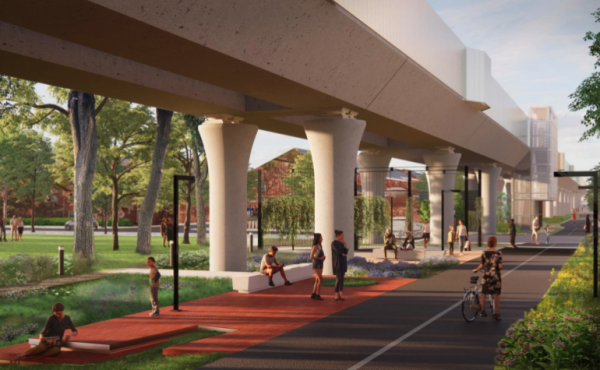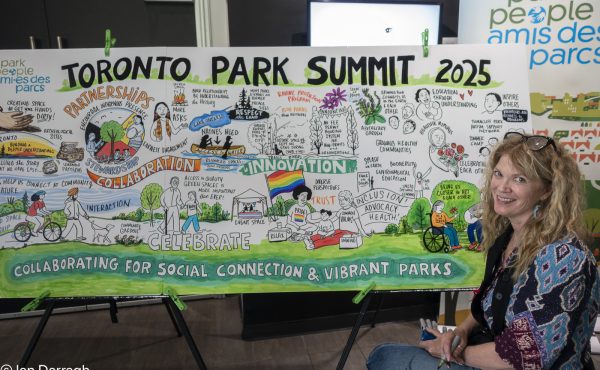Do children let bad weather stop them from walking to school? One of the reasons some parents give for driving their kids to school is the climate — that rainstorms and winter snow, cold and ice are a dangerous obstacle for children. At the recent meeting of the International Association for Travel Behaviour Research, I went to see a paper that addressed this problem head-on. Researchers from Ryerson and the University of Toronto looked at whether the number of children walking to school in Toronto dropped during the winter, or during weeks when the weather was bad.
The study used data from the Transportation Tomorrow Survey, picking out children of 11-12 who lived within walking distance of their school, generously defined as 3.2 km. That resulted in about 950 students. (They were originally going to include cycling, but only 17 students of that age cycled, so the sample was too small to work with). They then compared the percentage who walked in the fall to the percentage who walked in the winter.
The results showed that there was no difference at all in the percentage of kids who walked to school during the fall and the winter. In other words, winter weather had no effect on walking to school. As the presenter noted, “Children think that snow is fun. It’s not a problem for them, it’s a problem for the parents.” Turns out weather is more of an excuse than a reason for driving kids to school.
They also looked at whether the number of students walking to school was affected by rain during the fall, and they found no effect there either.
It’s important to establish this fact, because it means that investing in walking infrastructure and programs that will help get students walking to school is a worthwhile investment that will create a consistent improvement.
The study also found that, once they were over 1.6 km from their school, the number of kids walking to school dropped significantly. While hardly surprising, it’s important information to consider when we talk about school location and school closings. One of the reasons for the decline in the number of children walking to school is “school sprawl” — ever-bigger schools wider distances apart. While it may be more expensive for school boards, as a society we might save money elsewhere (e.g. improved health, reduced congestion) with a larger number of smaller schools.
Also interesting was that, even controlling for distance from school, children in the suburbs were less likely to walk to school than children in the old city of Toronto (despite the fact that in suburban areas sidewalks get ploughed in the winter, whereas in the old city of Toronto snow clearing is more erratic because property owners are responsible). Material for another study, certainly.






8 comments
Overbearing parents… give your child a break and let them walk to school!
I am in full support of walking to school (my kid has been doing it since he was 10) but this study seems pretty stupid to me. If your kid walks to school they walk to school every day no matter the weather. I think if they asked the question they would find that most kids who walk to school don’t have any other option. Either their parents don’t have a car or they have to leave for work too early to give the kids a lift.
Our new Toronto Chief Planner talking about walking to school: http://www.youtube.com/watch?v=vp549gsdjnk
It is also important to consider whether these students who walked to school would have been able to get a drive to school at all. In my experience, the students who walked to school in even the worse weather did so because there really wasn’t any other feasible means of transportation. Some families don’t have a car at all and others rely on one car often used by the parent with the farthest/ longest commute who need to leave early in the morning well before school time. As kids we had to walk to school despite bad weather. We didn’t necessarily enjoy the experience, but it was the only option. Occasionally due to safety concerns (mostly ice storms) we were accompanied on our walk by one of our parents. But a drive to school was a luxury, as it meant someone had to take time out of their work day and increase their commute to pass by my school. The only kids I remember who got a drive to school were from families with either two cars, or one parent who remained at home. Everyone else either walked or if they were far enough took the school bus. Therefore, improved walking infrastructure and more schools would not only encourage healthy and environmentally friendly commutes, but also help working families.
I think it’s somewhat unfair to parents to claim their reasons are just excuses — if they don’t want their kids walking to school in the cold, snow, whatever, then they have to build a morning schedule around being able to drive them as necessary. At which point, that becomes the morning schedule, because the logistics of getting kids to school and parents to work is complicated enough without introducing alternate schedules based on the weather.
#1 factor, distance. Even if you have cars and the time, if the school is just 5-10 minutes walk away, would you really bother to strap your kids in, finding a parking spot and so on? And weather really does not matter at that distance. More than anything else, higher density will help parents let kid walk to school.
Walking would be more competitive than the other modes of transportation after several changes: elimination of school buses for journeys of less than 3km, and imposing cost-recovery user fees above this threshold, amalgamating the four public school boards into one, and higher population density through elimination of height and minimum setback restrictions, requiring ground floor(s) of infill to be used for retail and office space, imposing maximum automobile parking of 0 for infill, decreasing development charges to 0 for infill and increased for low-density land use, eliminating land transfer taxes, and basing property taxes on the value of land alone rather than both land and building.
Misleading picture. That’s not a regular Toronto winter day, where the roads are dry or have a bit of slush, that’s a Montreal winter day or a once in three years Toronto storm day-after. Oh, and for the whole week that snow lingers after a storm in Toronto, if Torontonians are too witless and lazy to clear their sidewalks so children do not have to dodge the same witless and lazy people driving on snowy roads, wouldn’t it be great if the city fined them?